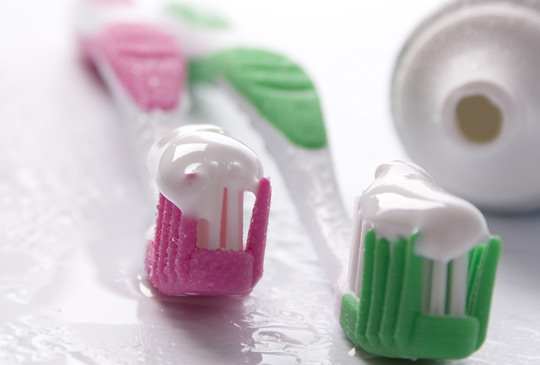Fluorine toothpaste: Beneficial and harmful
There is no denying the benefits of fluoride toothpaste. However, their abuse can be harmful, especially in areas where fluoride is contaminated in the water.
The benefits of fluorine in preventing tooth decay
Considered one of the top 10 achievements of the most well-known 20th- fluor century public health in the extremely close item is toothpaste.

Fluorine toothpaste is not used as much as it is good.
Double-edged sword
According to scientific documents, fluoride has many important roles for the body such as helping to prevent tooth decay , participating in bone and ligament structure, stimulating collagen synthesis in the early stages to restore broken bones, click Preferring bone cells to increase bone mass for the treatment of osteoporosis.
Enamel is the hardest organ of the body, the main component of enamel is apatite, fluoride can penetrate into tooth enamel and form fluoroapatite, making teeth stronger and less corroded by acid, thereby avoiding tooth decay. All of these effects are undeniable. However, Assoc.Prof.Dr. Nguyen Dinh Hoe, University of Natural Sciences said that any substance is also beneficial and harmful. They are only really useful when used properly.
PGS Hoe said that according to Vietnamese standards, the concentration of fluorine from 0.5 to 1mg / l is safe, if this content is used above the prescribed level, it will lead to brittle syndrome, fracture.
This is evident in the Phu Yen and Khanh Hoa regions - the areas with fluoridated water sources are called 'the land without smiles'. As a scientist who had a research topic on domestic fluoride pollution in these areas, PGS Hoe warned: The areas with fluoride contamination are similar to the addition of toxic substances to teeth. .
Instructions on how to choose toothpaste
Basic ingredients of toothpaste: fluoride content of less than 1500ppm, followed by abrasives, surfactants, antiseptic, essential oils, aromatherapy, abrasive . and fluoride with many types NaF, MFP, MmnF .

As recommended by dentists, adults should use toothpaste with a content of Fluor from 1000-1500ppm. Children choose toothpaste with a fluoride content of 200-450ppm:
- Popular toothpaste: A cream that contains fluoride of MFP type, can be in one tube with 1-2 types if the total content does not exceed the permitted level.
- Toothpastes : A type of toothpaste that is used to treat tooth decay, periodontal, anti-bad breath . needing the doctor's prescription, should not arbitrarily use can lead to chronic fluoride poisoning in children.
- Types of toothpaste: Cream in the form of silica, plastic cream with abrasive friction (DCP). Both meet the requirements of oral hygiene. It should be noted that for expired toothpaste, the effect of fluoride in it is reduced by 50-60%.
5 ways to use toothpaste flour to not poison
- Do not use toothpaste when: Land is fluoridated, using fluoride toothpaste will be a disaster for teeth. For children younger than 3 years of age, fluoride cream should not be used, except for children at high risk of tooth decay and adult supervision.
- Avoid the risk of excess fluoride: For adults, only a small layer of fluoride toothpaste is needed, not necessarily filled with the brush will be excess fluoride. To avoid excess, you can brush your teeth once a day with fluoride cream and once with salt water.
- Children who are susceptible to fluorosis in normal teeth are aged 1-4.
- Kinds suitable for children: To prevent tooth decay, children aged 3-6 should still use toothpaste with low fluoride content (200ppm-450ppm). Children should not use adult toothpaste for a long time, leading to excess teeth, fluorosis.
- What to do when there is excess fluor? Without a cure for adverse effects due to excess fluoride, only aesthetic method helps to mask white, brown, black spots on the surface of teeth and ways to improve dental health by Absorbs good food in everyday life.
- Flo in toothpaste derived from stars
- Use a lot of toothpaste easy to cancer of the oral cavity
- Tablet toothpaste helps protect the environment
- Check out the types of polar bacteria that are beneficial to humans
- The toothpaste tube will be replaced by the peel dissolved in the mouth
- Video: 5 other functions of toothpaste you may not know yet
- 11 great uses of toothpaste
- Use a lot of toothpaste that is dangerous to the nervous system
- Unknown things about brushes and toothpaste
- Chemicals in toothpaste can cause an increased risk of allergies
- Food is beneficial and harmful for hypertensive patients
- Eating fish eggs is beneficial or harmful?
 Green tea cleans teeth better than mouthwash?
Green tea cleans teeth better than mouthwash? Death kiss: This is why you should not let anyone kiss your baby's lips
Death kiss: This is why you should not let anyone kiss your baby's lips What is salmonellosis?
What is salmonellosis? Caution should be exercised when using aloe vera through eating and drinking
Caution should be exercised when using aloe vera through eating and drinking